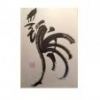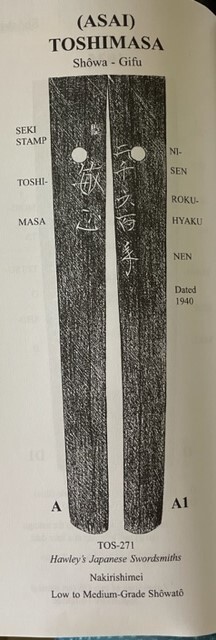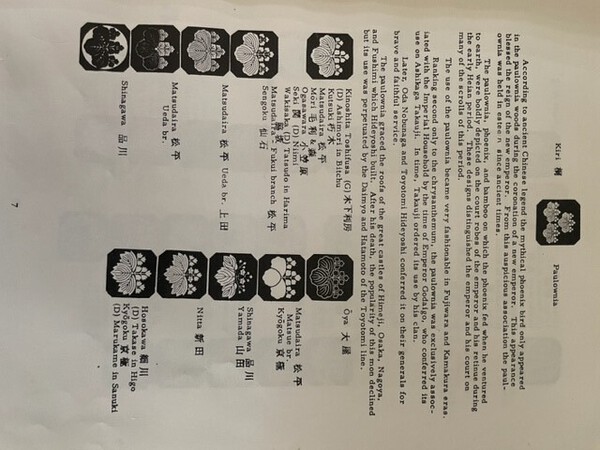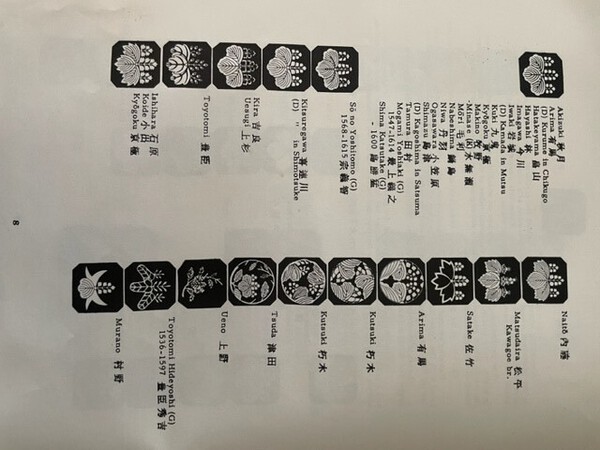-
Posts
837 -
Joined
-
Last visited
-
Days Won
10
Content Type
Profiles
Forums
Events
Store
Downloads
Gallery
Everything posted by mecox
-
Yes wife agrees with Morita san...electrical and/or communications/telephone components.
-

I Shouldn't even try - "something" fuji?
mecox replied to Bruce Pennington's topic in Translation Assistance
Takeyasu was a Toyokawa arsenal smith making stainless steel kai gunto 武泰作 with higaki yasurime. . Also had some mates called Takeyuki 武幸作 stainless steel with anchor in circle but osujikai filing and Takeyoshi 武吉作 (anchor). -
John, Ishido is his family name. There is a further compilation of Teruhide/Mitsunobu here page 49
-
Following the lists of early Showa period sword exhibitions reported there is often an 8th Nipponto Shinsaku Tenrankai in March 1943 omitted. Peter @Itomagoi has added some great photos about this and I have attempted to expand on it and give it historic context. Of note to @Kiipu@PNSSHOGUN@Bruce Pennington@george trotter sword exhibitions 1943.pdf
-

Please Identify The Sword Gunto Ww2
mecox replied to antiquegallery's topic in Military Swords of Japan
Paul & Thomas, yes KIKUHIDE (菊秀), from Gifu, real name Murayama Kikuo (村山菊雄), born September 21 1905 (Meiji38), died April 8 1952 (age 47). Registered as a Seki swordsmith Showa 18 (1943) Feb 17 living at Seki-machi, Yoshida-cho. The sword is May, 1944 (any stamps on it?). He does not appear to have produced much. But the above reference from Bruce (Nove 2022) appears to show a blade stamped with star and Gifu on late war blade, but he is not in Rikugun Jumei Tosho lists. -
Some very interesting material here on sword exhibitions thanks to: @Itomagoi @Kiipu @PNSSHOGUN @k morita To assist with following Peter's photos from the Tsuchika book about Kurihara, here are caption translations and some notes. Apparently there was an 8th Nipponto Shinsaku Tenrankai held in March, 1943, which was the last of these. The Army then took over sword exhibitions starting in November, 1943. This summary has now been updated. Sword Exhibitions + shinsa.pdf
-
Peter, terrific series of photos, thanks.
-
Gary, there is a useful 6 page summary of Kaga armour in Bob Benson's magazine Bushido: Burawoy, R. 1981.The Unkai School Armourers of Kaga. Bushido, 2, 3, 26-32, Honolulu, U.S.A. Here's a pic of armour from it.
-
The wire wrapped saya is interesting historically, as it reflects detailed work and a lot of time. Over the years I recall seeing a wide range of wrapped saya using string, cord, rope, rolled paper, leather and various tapes, also with cane (one is shown in F&G 1986 book...possibly by the Japanese officer?). Some of these are simple wrap around, but many others have detailed turns, knots and patterns. The knots often look like traditional naval knots. I have always assumed this wrapping was done near the end or post-war on captured or souvenir swords when the owner has plenty of time, such as waiting to be shipped or during shipping home. Any other ideas?
-

Arsenal Mark on RJT sword Fittings
mecox replied to george trotter's topic in Military Swords of Japan
Adding one more Star stamped RS 東京第一陸軍造兵廠 宣威 Tokyo first Army Arsenal Nobutaka 昭和十七年十二月吉日 1942.12 Trystan, I think this smith is “Nobutake” (宣威), family name Yoshihara (吉原). -

Interested in identifying this sword
mecox replied to Kyleb's topic in General Nihonto Related Discussion
Need info on the blade......length of cutting edge (nagasa), length of tang (nakago). Yes nakago is shortened for remounting but may have been earlier, not necessarily for WW2. The ornament under the wrapping is brass of 3 cherry blossums (sakura). You need to search this site for info in "shingunto". -

Interested in identifying this sword
mecox replied to Kyleb's topic in General Nihonto Related Discussion
Possibly is “Taikei Naotane” (大慶直胤) of Musashi worked in Bunsei (1818-1830) and had many students. Looks to be an early war remounted traditional sword in budget koshirae. Nakago is shortened and part of mei missing. Saya has a mon of 3 leaves (pointing out) could be water lilly ? But not sure. An example: ヤフオク! - 大慶直胤 花押 乱れ刃紋 青海波紋ハバキ 長さ6... (yahoo.co.jp) -
Bruce, I wonder if the larger slightly different anchor stamp could be a post-war made one?
-
I have bought from this seller in the past (around 10 years ago). One was a nicely made Seki Showato with a Sakura-sho stamp, with damaged wood/leather saya, clearly WW2 and I was pleased with it. The other was a shinsakuto blade, no shirasaya, nicely made, crisp mei of well known active Seki smith. I proudly sent a photo and oshigata to the tosho in Seki......he replied with a very nice Japanese card "thank you but it is not my sword". Having looked on and off at this seller, he does sell nice newly made blades with fake/forged mei, as well as other items. So you need to be sure what it is.
-
more on Kanehide in here:
-
John, good info on Kanehide in George Trotter download (similar green number style ..his "A14" yours "A930?"
-
John, looks a good blade. Can you show pics of all stamps, these are of interest.
-
Thanks Morita san. Uncommon "shige". He is: “Kaneshige” (兼茂), real name Sakai Katsutoshi (酒井勝利), (the F&G mei have 酒向) born March 19 (or 15) 1906 (Meiji 19). He was from Gifu, Seki-machi, Koze (?) and registered as a Seki swordsmith on Showa 16 (1941) April 4. There is little info about him, but he worked as a guntō smith, apparently in the Nagoya Arsenal ("na" stamp on @Bruce Pennington post). But two oshigata from F&G 1983 have Seki stamp. He is not listed in 1941 exhibition or 1942 banzuke, however, he is in the 1944 Army run exhibition. This was in December and ranked by Rikugun Gunto Gijutsu Shorei Kai, and he is one of 4 to received Presidents Award (Kyoshinsha) for zoheito.
-
-
Jacques has a good point. If I could offer some examples of various Kaga nakago jiri:
-
Colin, the nakago outline does look rather rough and I wonder if shortened a bit and reshaped? The hole looks well down also. Could the munemachi have been moved up a small bit (compared to remnant hamachi). Fitting to a new koshirae??
-
Good confirmation with Trystan!
-
Robert, looks to be TOSHIMASA (敏正) of Gifu – “Toshimasa” (敏正), real name Asai Eikurō (浅井栄九郎), born January 15th 1886, student of Watanabe Kanenaga (渡辺兼永), he worked as guntō smith and died October 25 1958 age 72. In 1942 ranked as Ryōkō no Retsu (in Akihide Banzuke list). He is listed in Slough book page 176. He registered as a Seki swordsmith in Showa 16 (1941) August 18, age 55.
-
The 3-5-3 kiri mon is relatively common with numerous branch families. And different branch mons vary in detail. The 5-7-5 is a much higher rank. Here's some examples from the Hawley mon book.
-
But in 1600's-1800's many "copper' coins were made from Cu alloys, but were also made from copper, also iron/Fe-alloy, so depends on period and location, and they were cast.













